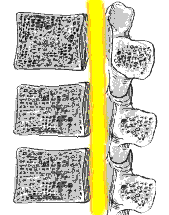
Why me so bother talking about osteoporosis? Because Dr Sajar told so.. muahahaha... Osteoporosis is under group of metabolic bone disorder.
Definition
Osteo - Bone; poro - Pores; osis - condition
Apleys: Can found any.. LoLZ
Stedman: reduction in quality of bone or atropy of skeletal tissue; occurs in postmenopausal women and elderly men, resulting in bone trabeculae that are scanty, thin, and without osteoclastic resorption
Risk factor
Why so important of knowing the risk factor? So we can screen early ler.. Later i will talk how do we screen. Of coz almost all women who are menopause will get this osteoporosis, but if patient got +ve risk factor, it might accelerate the osteoporosis so it's important for us so we can prevent it earlier
Risk Factors are (from apley):
- First Degree family history of Osteoporosis
- Ectomorphic somatotype???
- Hysterectomy done before
- Cigarette Smoking
- Dietary faddism?
WTF is ectomorphic somatotype?? Stupid apley. That's y i never like this book. The book is so simple without explanation.. Hate it so much.. nway.. just forget about it now..
If u are 70 years onwards, additional factors come into play.
- Diminished activities
- Chronic illness
- Dietary deficiency
Basically clinical features depend on which fracture site it occur.
Hip Fracture
Hip fractures are a major cause of loss of independence in older women and men. Overall about half of hip fractures are intertrochanteric and the others are femoral neck fractures. In older women the proportion of trochanteric fractures increases. Trochanteric fractures, but not femoral neck fractures, are related to bone density. Femoral neck fractures, on the other hand, may be more related to mechanical factors. The vast majority of hip fractures occur after a fall. About 5% appear to be "spontaneous" fractures, in which the patient feels a fracture and then falls.
About 60% of women with compression fractures
do not realize they have had a fracture! Vertebral compression fractures vary in degree from mild wedges to complete compression. The symptoms also vary, but the degree of compression is not necessarily related to the amount of pain. It is possible that some of the fractures occurred gradually and therefore did not cause acute pain. When women and men do suffer painful compression fractures, the pain usually lasts from 1 to 2 months, is localized to the back with accompanying muscle spasms, then gradually subsides macam simple muscle strain except lebih lama skit. Usually patients with continuing severe pain should be evaluated for other pathologic etiologies of the fracture, especially malignancy or myeloma. Persistent pain can also be caused by continuing fracture, muscle spasms, spinal stenosis, or degenerative joint disease.
Wrist FractureWrist fractures are more common in women who are 50 to 60 years old. These are caused by falls or other trauma. Osteoporosis does not appear to impair the healing of the wrist fractures, and they cause only short-term disability.
Others such as body shape and consequences
Kyphosis, Heigth loss, Protruding abdomen, decrease pulmonary capacity, reflux esophagitis
Investigations
Xrays
 To correctly interpret a spine xray, it is important to know the definition of a vertebral fracture, which is not quite as straightforward as it first appears. A vertebra can be considered fractured if the anterior height is 80% or less of the posterior height. A new fracture requires loss of at least 20% of anterior or posterior height. See picture on left.
To correctly interpret a spine xray, it is important to know the definition of a vertebral fracture, which is not quite as straightforward as it first appears. A vertebra can be considered fractured if the anterior height is 80% or less of the posterior height. A new fracture requires loss of at least 20% of anterior or posterior height. See picture on left.Xray of the long bones also typically shows an osteoporotic fracture. Usually there is a general reduction in radiographic bone density and abnormal thinning of the cortices. Therefore, here comes DEXA in terms of measuring bone density more accurately
DEXA
For medical student, by knowing what full name of the DEXA is sufficient. No need to know it in detail. Using DEXA is a gold standard to diagnose osteoporosis. It came out in my EOP, 2 years ago, LOLZ. However some centres, DEXA scan were used alot in terms of screening to those with high risk. Now you see the reason why we should know the risk of having it! However it still controversial..haha..
- Dexa scan for those women who have multiple risk factor particularly those with suspected low oestrogen or some other bone-losing disorder, and those who have suffered previous low energy fracture at the menopouse
- Calcium and Vitamin D supplement
- Avoid smoking and alcohol consumption
- Oestrogen medication (Hormone Replacement Therapy) is the most effective way of maintaining bone density. There was question related to PCM OSCE where we need to advice the patient of having HRT, but the problems about HRT are the complications.
- The newest drugs is Biphosphonates. It is a useful alternative to HRT. Biphosphonates have been shown to prevent bone loss and the to reduce the risk of vertebral and hip fractures.
Managed the fracture first - Internal fixation, rehabilitaion.
Then genaral treatment - Vit D and Calcium supplement, diet with this elements, expose to sunlight, exersice and treatment with Biphosphonates or HRT should also be considered to prevent further loss.
A nice Clinical Practice Guideline you can download here
There is also some Orthopaedic book i like to share. Click here








0 comments: